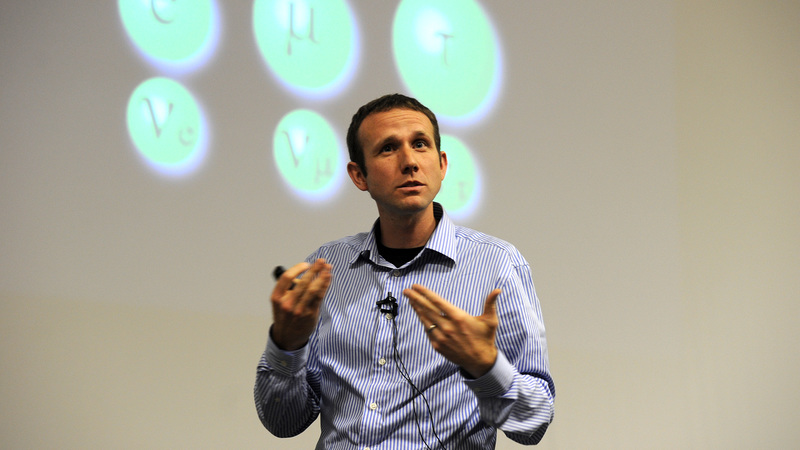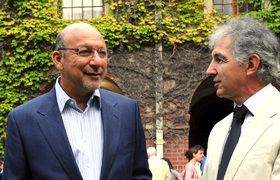Why the Higgs Boson matters
10 September 2012 | Story Newsroom.Public interest in physics spiked after the European Centre for Nuclear Research (CERN)'s announcement on July 4 that it had detected a particle that looked and behaved like the mythical Higgs Boson particle that scientists have spent decades searching for.
Many have been wondering just what all the fuss has been about.
UCT's Dr Andrew Hamilton's public lecture on 6 September, sub-titled by the above question, went some way to shedding light on that momentous moment in scientific history.
Hamilton spent five years working on the ATLAS project at the Large Hadron Collider (LHC) at the CERN, the decades-long experiment to detect the Higgs Boson particle, before joining UCT as lecturer in the Department of Physics in 2011. So, when the Faculty of Science invited the public to hear the physicist share insights into the Higgs-inspired public furore, it was no surprise to spot no empty seats. (Hamilton delivered the same lecture on Monday 10 September as a result of the interest.)
Particle physics, explains Hamilton, is understood through two main (and competing) models: the Standard Model, and Albert Einstein's theory of general relativity. The Higgs Boson is a fundamental - and, before 4 July, the only hypothetical - particle in the Standard Model.
"If you want to know how the molecules that make up your body stick together the way they do, how the sun shines, why the sky is blue, why water is liquid in temperatures found on earth, or why we don't fall through the floor, all of the answers are contained in the equation of the standard model," Hamilton summarises.
"This whole system, the Standard Model, only fits together if the Higgs Boson is there to make it work."
After the role of protons, electrons, neutrons, photons, quarks and neutrinos in the Standard Model equation were explained, the elephant in the room could be ignored no longer: what does the Higgs Boson do?
"It gives mass," says Hamilton. "Particles, both ones with mass and ones without mass, are free to go wherever they want, unless there's a Higgs field.
"The Higgs field slows massive particles down; gives them inertia, like dragging a spoon through honey."
The Higgs particle, named after physicist Peter Higgs who first proposed the notion of such a particle half a century ago, is the final piece of the Standard Model puzzle. The Boson bit is derived from the particle's nature. In addition to gluons, photons and W & Z bosons, the Higgs is proposed to be the final member of the boson family, named after Indian physicist Satyenda Nath Bose.
July 4 represented a milestone with the potential to click into place centuries of research into how nature functions at the most fundamental level.
Was it the Higgs, then, that was observed in the LHC?
"Likely," says Hamilton. "But it has not yet been proven conclusively."
Particle physics requires a five-sigma level of certainty for an official discovery to be declared, akin to several people all landing 'heads' 21 times in a row after flipping a coin, to prove that the coin has special qualities.
Hamilton's frank response to being asked what the Higgs Boson particle, if conclusively found, could be used for, drew mirth from the packed audience.
"I haven't the foggiest what we could possibly use the Higgs Boson for," he admitted to mirth from the packed audience. "But it is cool to know that the Standard Model works!"
 This work is licensed under a Creative Commons Attribution-NoDerivatives 4.0 International License.
This work is licensed under a Creative Commons Attribution-NoDerivatives 4.0 International License.
Please view the republishing articles page for more information.
















